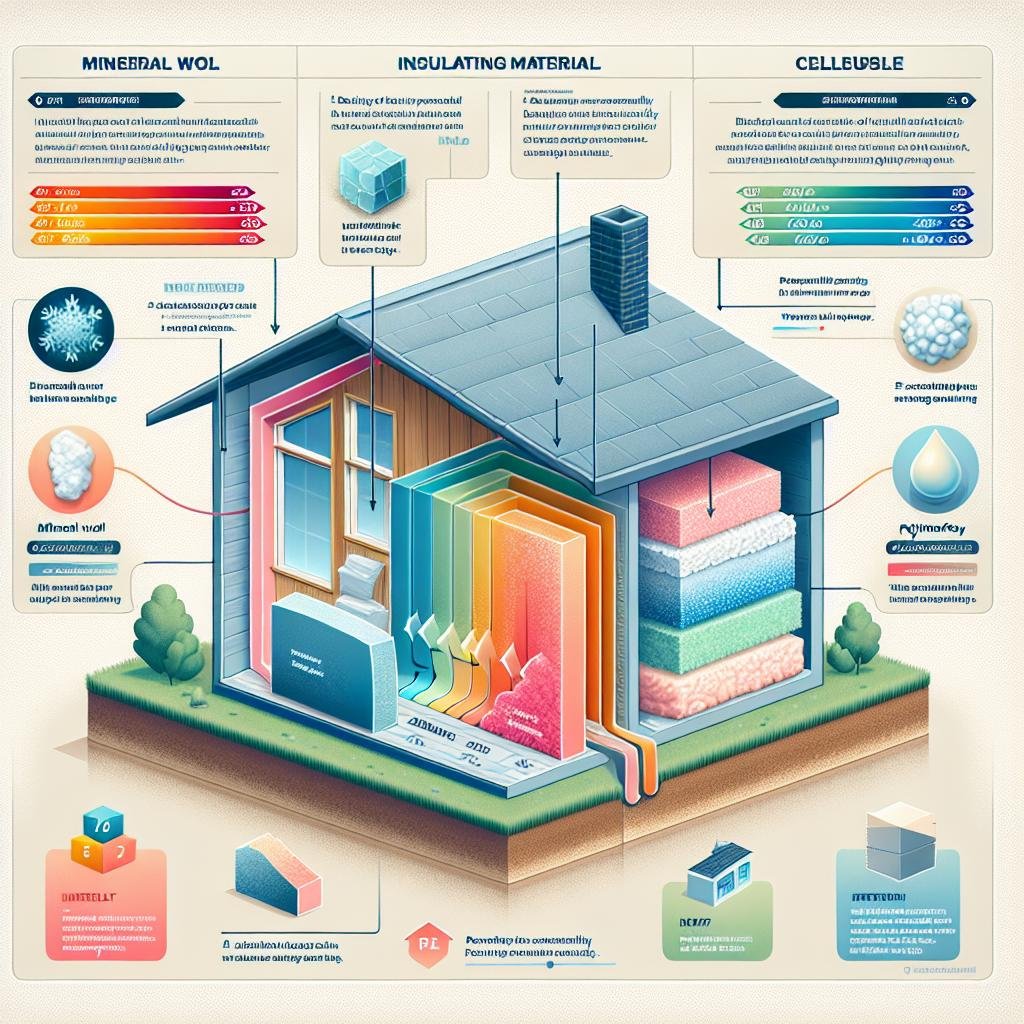Are you tired of sweating through the summer months despite cranking up your air conditioning system? Say goodbye to inefficient cooling and hello to a comfortable home all year round with the help of a mini split AC system! By properly insulating and sealing your home, you can maximize the efficiency of your mini split AC and keep your energy bills low. In this article, we will explore the best practices for insulating and sealing your home to achieve optimal cooling with a mini split AC system. Let’s dive in and create a cool oasis in your home!
Choosing the Perfect Insulation: Materials That Make a Difference
When it comes to making your mini split AC system work efficiently, selecting the right insulation is paramount. Begin by examining the materials that best suit your home’s specific needs. **Fiberglass insulation** is a conventional favorite, known for its affordability and ease of installation. This material not only resists moisture but also effectively reduces noise levels. On the other hand, **spray foam insulation** offers superior air sealing capabilities, filling gaps and crevices that other materials might miss. This ultimately curbs air leaks, ensuring that your home stays cool even during peak summer months.
- Fiberglass Insulation: Affordable, easy to install, moisture-resistant.
- Spray Foam Insulation: Superior air sealing, fills gaps, maximizes efficiency.
- Cellulose Insulation: Environmentally friendly, excellent at trapping air.
- Rigid Foam Board: High thermal resistance, perfect for compact spaces.
Another essential material to consider is **rigid foam board insulation**, notable for its high thermal resistance and suitability for compact areas where traditional insulation might not fit. For those interested in an eco-friendly option, **cellulose insulation** is made from recycled paper products and excels at trapping air within its fibers, creating an effective barrier against heat transfer. A smart choice of these materials can help ensure your mini split AC delivers optimal cooling, translating into a comfortable and energy-efficient home environment.
| Material | Benefits |
|---|---|
| Fiberglass | Affordable, moisture-resistant, noise reduction |
| Spray Foam | Air sealing, gap filling, efficiency |
| Cellulose | Eco-friendly, excellent at air trapping |
| Rigid Foam Board | High thermal resistance, compact spaces |

The Magic of Proper Sealing: Keeping Cool Air In and Hot Air Out
Proper sealing can make a world of difference in your home’s energy efficiency when using a mini split AC system. By ensuring every crack and crevice are sealed, you create a consistent barrier between the interior and exterior environments. This not only helps to maintain a refreshing cool temperature indoors but also prevents warm air from infiltrating your sanctuary. Consider using **weatherstripping** around doors and windows, applying **caulking** to seal gaps in the structure, and installing **door sweeps** to block under-door drafts. All these efforts, though minor in appearance, add up to significant savings on your energy bills and a more comfortable living space.
To further enhance the benefits of proper sealing, look at some home insulation tips that pair perfectly with your mini split AC system. Inspect attic and wall insulation levels, ensuring they’re up to modern standards. **Insulation Tips:**
- Use **spray foam** for those hard-to-reach areas.
- Install **reflective barriers** in attics to repel heat.
- Check **ductwork** for any leaks, sealing them with mastic or foil-backed tape.
| Sealing Method | Energy Savings |
|---|---|
| Weatherstripping | 10-15% |
| Caulking | 5-10% |
| Door Sweeps | 2-5% |
Implementing these practices makes your mini split AC system more efficient and your home more eco-friendly, all while staying cool.
Understanding Mini Split AC Placement for Optimal Efficiency
Placing your mini split AC system in the optimal location is key to ensuring efficient cooling and a comfortable indoor environment. Consider installing the indoor unit high on the wall in frequently used rooms like the living room or bedroom. This position allows for better air circulation and more effective cooling. **Avoid placing the unit near heat sources** such as ovens and direct sunlight, as this can affect your system’s efficiency and performance. Additionally, keeping doors and windows closed in the rooms where the mini split is operating helps to maintain the desired temperature more effectively.
**Important factors** to remember during installation include ensuring the outdoor unit has proper airflow and is shielded from extreme weather conditions. Placing it on a solid, stable surface away from obstructions and heavy foot traffic will prolong its lifespan and operational efficiency. Here’s a quick overview:
| Indoor Unit | Outdoor Unit |
|---|---|
| Avoid direct sunlight | Away from obstructions |
| Place high on the wall | Good airflow |
| Keep doors/windows closed | Sturdy surface |

DIY Tips and Tricks: Easy Steps to Enhance Your Home’s Cooling
Insulating and sealing your home can dramatically enhance the efficiency of a mini split AC system. Begin with your windows and doors: these are typically the main culprits for unwanted heat gain. Install **weather stripping** around doors and windows to prevent cool air from escaping. For an extra seal, use **caulking** to fill in any gaps and cracks. Don’t forget to check your attic and basement; insulating these areas can create a remarkable difference in temperature regulation. Try using **spray foam insulation** for those hard-to-reach nooks and crannies, as it expands to fill spaces and provides an air-tight seal. Remember, a well-insulated home not only stays cooler during summer but also retains warmth in the winter.
Using a mini split AC system efficiently is not just about insulation; **proper sealing of ducts** is equally crucial. Leaky ducts can lead to significant cooling losses, making your system work harder than necessary. Use **mastic sealant** or **metal foil tape** for the best results. If you’re in an older home, consider upgrading your ductwork to more modern, energy-efficient materials. Breathe easier by ensuring **ventilation in attics and crawl spaces**—this helps in maintaining air quality and prevents unwanted humidity build-up. Here’s a quick breakdown of essential materials and where to apply them:
| Material | Application Area |
|---|---|
| Weather Stripping | Windows, Doors |
| Caulking | Windows, Door Frames |
| Spray Foam Insulation | Attics, Basements |
| Mastic Sealant | Ductwork |
Q&A
Q&A: The Best Practices for Insulating and Sealing Your Home for Efficient Cooling with a Mini Split AC System
Q: Why is it crucial to focus on insulation and sealing for efficient cooling with a mini split AC system?
A: Great question! Insulation and sealing are like the dynamic duo of home comfort. Think of insulation as your home’s cozy blanket that keeps cool air in during sweltering summer days, making your mini split system work smarter, not harder. Sealing, on the other hand, is the fortress wall that blocks warm air from sneaking in and sabotaging your chill vibes. Combined, they help your mini split AC operate efficiently, saving you energy and money.
Q: What areas in the home should I prioritize for insulation to maximize my mini split AC’s efficiency?
A: You’re on the right path! Start with the attic, as it tends to be the biggest culprit when it comes to heat gain. Then, move on to your walls, particularly those that face the sun throughout the day. Don’t forget about the floors over unconditioned spaces like basements or crawl spaces. windows and doors are often overlooked, but they can be significant sources of air leaks. Insulating these areas can make a noticeable difference.
Q: Can you recommend some materials for insulation that work well?
A: Absolutely! Here are a few fan favorites:
- Fiberglass insulation – Affordable and versatile, perfect for attics and walls.
- Spray foam insulation – Offers high R-values and excellent air-sealing properties, great for hard-to-reach spots.
- Cellulose insulation – Eco-friendly and effective, ideal for walls and attic spaces.
- Rigid foam boards – Good for basement walls and exterior foundation walls.
Just pick the material that best suits your needs and your home’s structure!
Q: How can I identify and seal air leaks effectively?
A: Detective mode: activated! Start with a thorough inspection of common leakage points: around windows and doors, at electrical outlets, and where pipes and wires enter your home. A simple, yet effective trick is the “smoke test”: hold a smoke stick or incense near these areas and watch for smoke movement. If it’s wavering or being sucked out, you’ve got a leak! Seal these gaps using caulk for smaller cracks and expanding spray foam for larger gaps. Don’t forget weatherstripping around doors and windows!
Q: What role does ventilation play in conjunction with insulation and sealing?
A: Excellent point! While sealing and insulating keep your cool air in, proper ventilation ensures that your home won’t feel stuffy. It helps maintain indoor air quality by allowing fresh air to circulate and controlling moisture levels, preventing mold growth. Balance is key: you want an airtight seal, but also strategic ventilation such as exhaust fans or trickle vents to keep the air fresh and healthy.
Q: Are there any seasonal considerations for maintaining insulation and sealing?
A: Timing is everything! Before summer hits, do a once-over to check for any wear and tear from winter that could compromise your insulation and seals. This includes inspecting attic insulation, sealing any new gaps or cracks that may have formed, and checking your ventilation systems. If seasonal temperature shifts cause materials to expand and contract, they can create new leaks, so regular maintenance is your best friend.
Q: Can improving insulation and sealing help reduce my overall energy bills?
A: You bet! By preventing cool air from escaping and warm air from intruding, your mini split AC system doesn’t have to run constantly to maintain your desired temperature. This efficiency translates directly to lower energy usage and, consequently, lower bills. It’s an investment that pays off in comfort and cash!
Q: Do you have any tips for homeowners who want to DIY their insulation and sealing?
A: Roll up those sleeves! For DIY enthusiasts, start small: weatherstripping doors and windows is an easy weekend project. Use caulk to seal smaller gaps and cracks around fixtures—even those little leaks add up! For insulation, if you’re confident, you can roll out fiberglass insulation in the attic. Just remember to wear protective gear. When in doubt, don’t hesitate to call a pro. Safety and effectiveness go hand in hand!
And there you have it! By focusing on these best practices for insulating and sealing your home, your mini split AC system will keep you cool more efficiently and economically. Here’s to a comfy, cost-effective home adventure!
The Conclusion
As the golden sun retires and the night begins to weave its velvety tapestry, your home, now cocooned in impeccable insulation and meticulously sealed, stands as a fortress of cool tranquility. By embracing the best practices for insulating and sealing, you’ve orchestrated a symphony of efficiency where every breath of your mini split AC system harmonizes with your desire for serenity.
With each meticulous step, from weather stripping to attic insulation, you’ve not just created a space but an oasis where comfort meets sustainability. So, as you bask in the gentle coolness that wraps around you like a comforting embrace, remember that your efforts extend beyond mere temperature control. You’ve sculpted a sanctuary of well-being, safeguarding your haven against the sweltering embrace of summer.
Here’s to you, the architect of comfort, the curator of cool. May your home continue to be a sanctuary of efficiency and ease, where each sunbeam dances outside, celebrating the serene climate within. Embrace the gentle hum of your mini split AC, a testament to your ingenuity and foresight. Cheers to cooler days and nights filled with restful slumber, knowing you’ve mastered the art of an efficiently cooled home.

